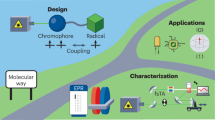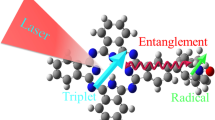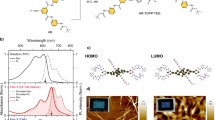Abstract
From biological complexes to devices based on organic semiconductors, spin interactions play a key role in the function of molecular systems. For instance, triplet-pair reactions impact operation of organic light-emitting diodes as well as photovoltaic devices. Conventional models for triplet pairs assume they interact only weakly. Here, using electron spin resonance, we observe long-lived, strongly interacting triplet pairs in an organic semiconductor, generated via singlet fission. Using coherent spin manipulation of these two-triplet states, we identify exchange-coupled (spin-2) quintet complexes coexisting with weakly coupled (spin-1) triplets. We measure strongly coupled pairs with a lifetime approaching 3 μs and a spin coherence time approaching 1 μs, at 10 K. Our results pave the way for the utilization of high-spin systems in organic semiconductors.
This is a preview of subscription content, access via your institution
Access options
Subscribe to this journal
Receive 12 print issues and online access
$209.00 per year
only $17.42 per issue
Buy this article
- Purchase on Springer Link
- Instant access to full article PDF
Prices may be subject to local taxes which are calculated during checkout





Similar content being viewed by others
References
Ritz, T., Thalau, P., Phillips, J. B., Wiltschko, R. & Wiltschko, W. Resonance effects indicate a radical-pair mechanism for avian magnetic compass. Nature 429, 177–180 (2004).
Baker, W., McCamey, D., Van Schooten, K., Lupton, J. M. & Boehme, C. Differentiation between polaron-pair and triplet-exciton polaron spin-dependent mechanisms in organic light-emitting diodes by coherent spin beating. Phys. Rev. B 84, 165205 (2011).
Lubitz, W., Lendzian, F. & Bittl, R. Radicals, radical pairs and triplet states in photosynthesis. Acc. Chem. Res. 35, 313–320 (2002).
Rao, A. et al. The role of spin in the kinetic control of recombination in organic photovoltaics. Nature 500, 435–439 (2013).
Nguyen, T. D., Ehrenfreund, E. & Vardeny, Z. V. Spin-polarized light-emitting diode based on an organic bipolar spin valve. Science 337, 204–209 (2012).
Swenberg, C. E., Geacintov, N. & Birks, J. in Organic Molecular Photophysics (ed. Birks, J. B.) 489–564 (Wiley, 1973).
Smith, M. B. & Michl, J. Singlet fission. Chem. Rev. 110, 6891–6936 (2010).
Smith, M. B. & Michl, J. Recent advances in singlet fission. Annu. Rev. Phys. Chem. 64, 361–386 (2013).
Congreve, D. N. et al. External quantum efficiency above 100% in a singlet-exciton-fission-based organic photovoltaic cell. Science 340, 334–337 (2013).
Tabachnyk, M., Ehrler, B., Bayliss, S., Friend, R. H. & Greenham, N. C. Triplet diffusion in singlet exciton fission sensitized pentacene solar cells. Appl. Phys. Lett. 103, 153302 (2013).
Burdett, J. J. & Bardeen, C. J. Quantum beats in crystalline tetracene delayed fluorescence due to triplet pair coherences produced by direct singlet fission. J. Am. Chem. Soc. 134, 8597–8607 (2012).
Burdett, J. J., Piland, G. B. & Bardeen, C. J. Magnetic field effects and the role of spin states in singlet fission. Chem. Phys. Lett. 585, 1–10 (2013).
Wang, R. et al. Magnetic dipolar interaction between correlated triplets created by singlet fission in tetracene crystals. Nat. Commun. 6, 8602 (2015).
Yarmus, L., Rosenthal, J. & Chopp, M. Epr of triplet excitions in tetracene crystals: spin polarization and the role of singlet exciton fission. Chem. Phys. Lett. 16, 477–481 (1972).
Bayliss, S. L. et al. Geminate and nongeminate recombination of triplet excitons formed by singlet fission. Phys. Rev. Lett. 112, 238701 (2014).
Chernick, E. T. et al. Pentacene appended to a tempo stable free radical: the effect of magnetic exchange coupling on photoexcited pentacene. J. Am. Chem. Soc. 137, 857–863 (2015).
Mauck, C. M., Brown, K. E., Horwitz, N. E. & Wasielewski, M. R. Fast triplet formation via singlet exciton fission in a covalent perylenediimide-β-apocarotene dyad aggregate. J. Phys. Chem. A 119, 5587–5596 (2015).
Teki, Y., Miyamoto, S., Iimura, K., Nakatsuji, M. & Miura, Y. Intramolecular spin alignment utilizing the excited molecular field between the triplet (S = 1) excited state and the dangling stable radicals (S = 1/2) as studied by time-resolved electron spin resonance: observation of the excited quartet (S = 3/2) and quintet (S = 2) states on the purely organic π-conjugated spin systems. J. Am. Chem. Soc. 122, 984–985 (2000).
Murai, H., Safarik, I., Torres, M. & Strausz, O. P. Triplet ground-state benzoylphenylmethylene and its quintet ground-state triplet–triplet radical pair. J. Am. Chem. Soc. 110, 1025–1032 (1988).
Odom, S. A., Parkin, S. R. & Anthony, J. E. Tetracene derivatives as potential red emitters for organic LEDs. Org. lett. 5, 4245–4248 (2003).
Burdett, J. J., Gosztola, D. & Bardeen, C. J. The dependence of singlet exciton relaxation on excitation density and temperature in polycrystalline tetracene thin films: kinetic evidence for a dark intermediate state and implications for singlet fission. J. Chem. Phys. 135, 214508 (2011).
Merrifield, R., Avakian, P. & Groff, R. Fission of singlet excitons into pairs of triplet excitons in tetracene crystals. Chem. Phys. Lett. 3, 386–388 (1969).
Bayliss, S. L. et al. Localization length scales of triplet excitons in singlet fission materials. Phys. Rev. B 92, 115432 (2015).
Stern, H. L. et al. Identification of a triplet pair intermediate in singlet exciton fission in solution. Proc. Natl Acad. Sci. USA 112, 7656–7661 (2015).
Schweiger, A. & Jeschke, G. Principles of Pulse Electron Paramagnetic Resonance (Oxford University Press on Demand, 2001).
Bencini, A. & Gatteschi, D. Electron Paramagnetic Resonance of Exchange Coupled Systems (Springer Science & Business Media, 2012).
Keevers, T. & McCamey, D. Theory of triplet–triplet annihilation in optically detected magnetic resonance. Phys. Rev. B 93, 045210 (2016).
Johnson, R. & Merrifield, R. Effects of magnetic fields on the mutual annihilation of triplet excitons in anthracene crystals. Phys. Rev. B 1, 896–902 (1970).
Swenberg, C., Van Metter, R. & Ratner, M. Comments on exciton fission and electron spin resonance in tetracene single crystals. Chem. Phys. Lett. 16, 482–485 (1972).
Budil, D. E. & Thurnauer, M. C. The chlorophyll triplet state as a probe of structure and function in photosynthesis. BBA Bioenergetics 1057, 1–41 (1991).
El-Sayed, M., Leung, M. & Lin, C. Pmdr spectroscopy and the geometry of the triplet state. Chem. Phys. Lett. 14, 329–334 (1972).
Kraffert, F. et al. Charge separation in PCPDTBT:PCBM blends from an EPR perspective. J. Phys. Chem. C 118, 28482–28493 (2014).
Wilson, J. S. et al. The energy gap law for triplet states in Pt-containing conjugated polymers and monomers. J. Am. Chem. Soc. 123, 9412–9417 (2001).
Astashkin, A. & Schweiger, A. Electron-spin transient nutation: a new approach to simplify the interpretation of esr spectra. Chem. Phys. Lett. 174, 595–602 (1990).
Hahn, E. L. Spin echoes. Phys. Rev. 80, 580–594 (1950).
Baker, W., Keevers, T., Lupton, J. M., McCamey, D. & Boehme, C. Slow hopping and spin dephasing of coulombically bound polaron pairs in an organic semiconductor at room temperature. Phys. Rev. Lett. 108, 267601 (2012).
Rondin, L. et al. Magnetometry with nitrogen-vacancy defects in diamond. Rep. Prog. Phys. 77, 056503 (2014).
McLauchlan, K. A. & Steiner, U. Invited article: the spin-correlated radical pair as a reaction intermediate. Mol. Phys. 73, 241–263 (1991).
Deigen, M. & Pekar, S. Hyperfine interactions and spin-electron resonance in polarons and excitons. Sov. Phys. JETP 34, 471–473 (1958).
Sternlicht, H. & McConnell, H. M. Paramagnetic excitons in molecular crystals. J. Chem. Phys. 35, 1793–1800 (1961).
Bayliss, S. L. et al. Spin signatures of exchange-coupled triplet pairs formed by singlet fission. Phys. Rev. B 94, 045204 (2016).
Wakasa, M. et al. What can be learned from magnetic field effects on singlet fission: role of exchange interaction in excited triplet pairs. J. Phys. Chem. C 119, 25840–25844 (2015).
Steiner, U. E. & Ulrich, T. Magnetic field effects in chemical kinetics and related phenomena. Chem. Rev. 89, 51–147 (1989).
Dick, B. & Nickel, B. Accessibility of the lowest quintet state of organic molecules through triplet–triplet annihilation; an indo ci study. Chem. Phys. 78, 1–16 (1983).
Singh-Rachford, T. N. & Castellano, F. N. Photon upconversion based on sensitized triplet–triplet annihilation. Coord. Chem. Rev. 254, 2560–2573 (2010).
Kondakov, D., Pawlik, T., Hatwar, T. & Spindler, J. Triplet annihilation exceeding spin statistical limit in highly efficient fluorescent organic light-emitting diodes. J. Appl. Phys. 106, 124510 (2009).
Baldo, M. A., Adachi, C. & Forrest, S. R. Transient analysis of organic electrophosphorescence. II transient analysis of triplet–triplet annihilation. Phys. Rev. B 62, 10967–10977 (2000).
Reineke, S., Schwartz, G., Walzer, K. & Leo, K. Reduced efficiency roll-off in phosphorescent organic light emitting diodes by suppression of triplet–triplet annihilation. Appl. Phys. Lett. 91, 123508 (2007).
Thompson, N. J. et al. Energy harvesting of non-emissive triplet excitons in tetracene by emissive PbS nanocrystals. Nat. Mater. 13, 1039–1043 (2014).
Acknowledgements
L.R.W. thanks the Gates-Cambridge Trust and Winton Programme for the Physics of Sustainability. This work was supported by the Freie Universität Berlin within the Excellence Initiative of the German Research Foundation. We also acknowledge support from the Engineering and Physical Sciences Research Council Grants No. EP/G060738/1. We thank A. D. Chepelianskii for helpful input.
Author information
Authors and Affiliations
Contributions
L.R.W. and S.L.B. analysed the data. F.K., J.B., L.R.W. and S.L.B. carried out the experiments. K.J.T. and J.E.A. provided the materials. All authors discussed the results. L.R.W. and S.L.B. wrote the manuscript with input from all authors.
Corresponding authors
Ethics declarations
Competing interests
The authors declare no competing financial interests.
Supplementary information
Supplementary information
Supplementary information (PDF 586 kb)
Rights and permissions
About this article
Cite this article
Weiss, L., Bayliss, S., Kraffert, F. et al. Strongly exchange-coupled triplet pairs in an organic semiconductor. Nature Phys 13, 176–181 (2017). https://doi.org/10.1038/nphys3908
Received:
Accepted:
Published:
Issue Date:
DOI: https://doi.org/10.1038/nphys3908
This article is cited by
-
Singlet fission initiating organic photosensitizations
Scientific Reports (2024)
-
Entangled spin-polarized excitons from singlet fission in a rigid dimer
Nature Communications (2023)
-
Quintet formation, exchange fluctuations, and the role of stochastic resonance in singlet fission
Communications Physics (2023)
-
Singlet fission as a polarized spin generator for dynamic nuclear polarization
Nature Communications (2023)
-
Exchange controlled triplet fusion in metal–organic frameworks
Nature Materials (2022)



